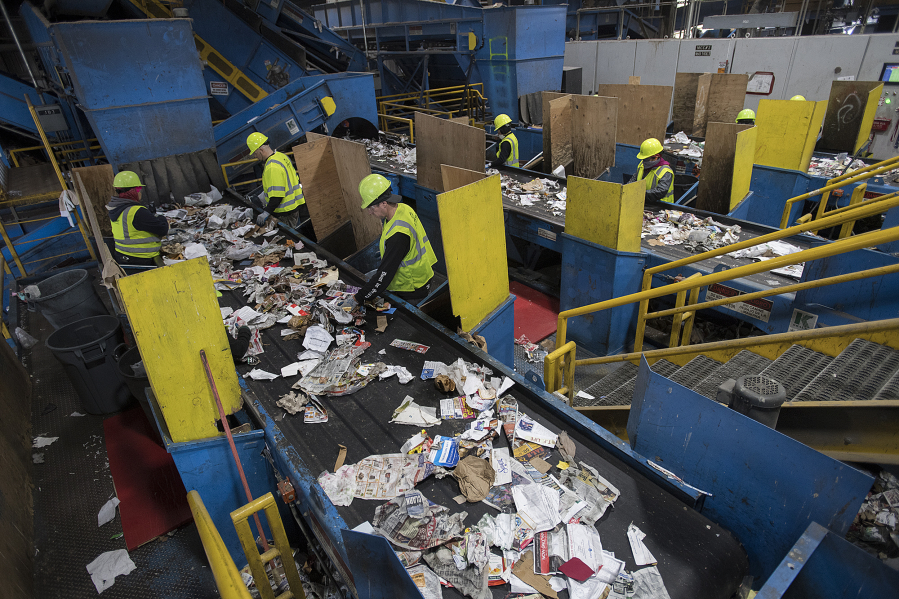During a weekday morning at the West Vancouver Materials Recovery Center, a truck dumped its load on the concrete floor of the center, a glass bottle could be heard breaking.
Jason Hudson, division president of Waste Connections, Inc. (which operates the facility) explained that the bottle should have gone in a different bin. He also picked out other contaminants, six-pack rings, Styrofoam, pet-food bags and plastic bags that well-meaning consumers errantly placed in the bins in hopes of them being recycled.
“You can see quite a bit of (plastic) film in this load,” said Hudson, referring to another contaminant that’s notorious for gunking up recycling equipment and polluting bales of recycled paper.
Each day, a parade of trucks dump loads of paper, cardboard, packaging, bottles and cans, and other recyclables Clark County residents have placed in bins. These loads also contain a problem that’s long vexed the recycling industry and may soon come to a head locally and across the country.
Contaminants have been an ongoing problem for the recycling industry. China, the largest end market for the U.S.’s recyclables, has signaled it’ll soon start refusing contaminated materials. In Washington, and the rest of the country, recyclers are bracing for the situation. Hudson said that at worst, recyclable materials will be dumped in a landfill.
“I don’t think it will get to that point,” he added.
Major customer
According to a report released last month by the Institute of Scrap Recycling Industries, a Washington D.C.-based industry group, last year China was the largest consumer of U.S. recyclables seeing $5.2 billion worth of materials sent to the rapidly developing country. The report also notes that China’s trade policies are a challenge.
Recyclable commodities sent to China from the U.S., Australia and Europe have been contaminated or poor quality. In 2013, China launched its “Green Fence” initiative, which was intended to improve the quality of bales of recycled paper and plastic imported into the country.
In spring 2017, China launched its “National Sword” effort, putting new restriction on the import of recyclables in hopes of stopping contaminated material from reaching the country.
In July, China notified the World Trade Organization that by the end of the year, it would crack down on imports of “dirty wastes” used for raw materials, including “mixed plastics” and “unsorted waste paper.”
Andrew Wineke, spokesman for the Washington State Department of Ecology, said that recycling companies and local governments are anticipating how China’s new regulations might affect them and are considering what materials they will accept. He said some recyclers have stopped accepting low-grade plastics or mixed paper, materials that are chronically contaminated.
Long-running problem
Wineke said that Oregon has a statewide ban on placing recycling in landfills. Earlier this month, OPB reported that the Department of Environmental Quality has received more than a dozen requests for permission to dispose of recyclable material. Washington doesn’t have the same ban, but counties can pass their own prohibitions, Wineke said. King County is the only county with such a ban, he said.
“This isn’t a new issue,” Wineke said. “The Chinese are not wrong to be concerned about this. We do need to improve the quality of our recycling stream.” He added, “This is really just coming to head now.”
So far, neither the city of Vancouver or Clark County has made any changes to local recycling programs in response to the situation, according to Rich McConaghy, environmental resources manager with the city.
Under China’s new regulations, all recyclable materials imported into the country may not exceed 0.3 percent contamination. According to a Department of Ecology fact sheet, this exceeds standards set by Institute of Scrap Recycling Industries, which allows for contamination levels between 1.5 percent to 5 percent. The department expects the regulations to render virtually all recovered recyclables ineligible for sale to China.
Wineke said the department has been advising local governments not to change long-term policies based in response to the situation. He said that some recycling processors have slowed down their operations in hopes of reducing contamination to levels where China will accept their materials.
Hand-sorting
At the West Vancouver Materials Recovery Center, streams of recyclables are zipped along conveyor belts where contaminants are removed mechanically and with laborers who manually pick out junk from a conveyor belt. But despite the effort, Hudson said some contaminants get through.
On a tour of the facility, Hudson held up a full bicycle wheel (which isn’t recyclable) that someone had left in their recycling and pointed to a tennis ball someone tried to recycle. He also stopped to pick out bits of plastic bags and film from a heap of processed paper.
But he said that the outgoing bales of recyclables from the facility rate have a contamination level of 2 percent, which he said is some of the cleanest material produced in the region. He said he doesn’t expect any facility on the West Coast to hit the 0.3 percent standard.
“We’re kind of in a wait and see mode,” Hudson said. Typically, Hudson said the facility processes 90,000 tons of material a year. But recently, he said it’s slowed down operations, processing about 15 to 16 tons of material an hour down from the 24 to 25 it used to do.
McConaghy said that recycling companies used to have the option of sending recycled paper to local mills. But he said that many of these mills have closed.
Not just China
Hudson said that not all of the facility’s recyclables go to China and that the company began looking for different end markets after the country enacted its Green Fence initiative in 2013. He said that most of the cardboard, glass, as well as metals, such as tin and aluminum, processed at the facility are sent to domestic markets.
But Hudson said that 66 percent of mixed recycled paper is consumed by China. He said that demand won’t go away and he will be waiting hopefully to see if the Chinese government allows it to be imported.
“The demand is still there,” he said. “The supply is still there.”
Wineke said that the Department of Ecology is still encouraging consumers to recycle because it uses less energy and resources to manufacture products while producing fewer greenhouse gases. He said that if a consumer is unsure if something can be recycled, they should check the product’s label or contact their local government.
McConaghy referred to a “Recycling Done Right,” which was published for Clark County residents in 2015 as a guide for what can and can’t be placed in recycling bins.
Hudson said that if a consumer is unsure if something can be recycled he offered the advice, “When in doubt, throw it out.”
“Otherwise it’s going to be a long trip to the landfill,” McConaghy added.




